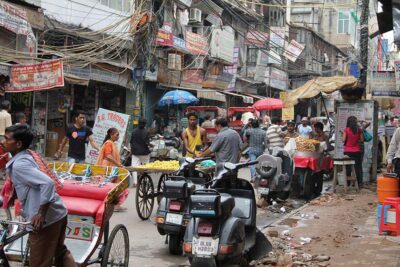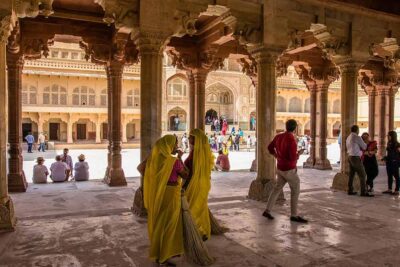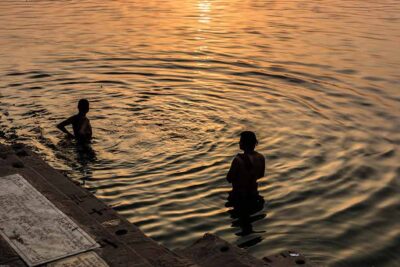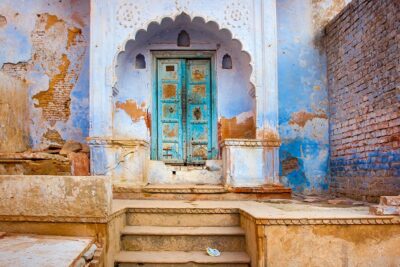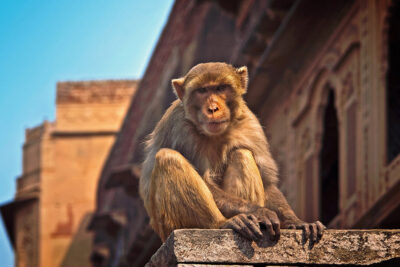Trinath Yatra: a pilgrimage to India among Pushkar, Vrindavan and Varanasi
12 days
What we offer is an experiential journey through Northern India, built around symbolic places, tangible social projects, and moments of deep immersion in local traditions. The itinerary is designed for those who want to understand the country through three key dimensions of Hindu culture: creation, preservation, and transformation—represented by the deities Brahma, Vishnu, and Shiva. In Sanskrit, Trinath refers to the three aspects of the supreme being, while Yatra describes a path of growth and discovery that passes through three sacred cities: Pushkar, Vrindavan, and Varanasi.
The journey begins in Delhi, the capital of India, where visits to historic landmarks are paired with a meaningful experience: a walking tour led by former street children, now trained by an NGO operating in the Paharganj district. It’s a powerful introduction to the country’s urban and social complexity, seen from the perspective of those who have lived it.
The second stop is Nawalgarh, a small town in Rajasthan known for its frescoed havelis, where guests stay in a structure linked to community development initiatives. Here, travelers encounter a more rural and authentic side of India: wandering through colorful bazaars, exploring historic mansions, riding camels through the countryside, and enjoying an evening of live Indian classical music.
Next, the journey leads to Pushkar, a sacred town dedicated to Brahma, the creator in the Hindu pantheon. Visitors explore the only temple in India devoted to this deity, witness the evening rituals on the shores of the sacred lake, and absorb the unique spiritual atmosphere of this desert-edge town. On the way to Jaipur, there’s a stop in Tilonia, home to the Barefoot College—an NGO that promotes rural self-reliance and solar energy through innovative educational programs.
In Jaipur, the capital of Rajasthan, travelers discover its most iconic sites—Amber Fort, Hawa Mahal, and the historic old city—before heading to Vrindavan, a town associated with Krishna, considered an incarnation of Vishnu. Here, the journey becomes more participatory: visiting temples, observing devotional rituals, and engaging with an organization that supports vulnerable women, migrants, and marginalized communities. Each participant has the chance to practice karma yoga by taking part in a day of selfless service.
The final leg of the journey takes place in Varanasi, the sacred city dedicated to Shiva, where spirituality manifests in its most visible form: collective rituals on the Ganges, cremation ceremonies, pilgrimages, prayers, and meditation. Highlights include visits to Manikarnika Ghat and Mukti Bhawan, a facility where people come to spend their final days, seeking liberation from the cycle of rebirth. The journey concludes with a visit to Sarnath, where Buddha gave his first teaching—offering one final layer of insight into India’s multifaceted spiritual heritage.
JOURNEY OVERVIEW AND PROGRAM DETAILS
1° DAY: ARRIVAL IN NEW DELHI
Arrival at New Delhi International Airport, meeting with our staff just outside the terminal and transfer to the hotel to rest. Some of the most famous attractions include the Red Fort, the Mughal Gardens, the Akshardham Temple, the Lotus Temple, and Raj Ghat. After resting, you will visit Jama Masjid, the main mosque of Old Delhi (each year nearly 25,000 people visit and pray at this mosque). Here an ancient copy of the Holy Quran, written on deerskin, is preserved. Walk through the narrow streets of this part of the city such as Chawri Bazar, one of the most crowded areas of Old Delhi. Afterwards, visit to the Red Fort (external visit), also called Lal Qila or Qil’ah, built by the Mughal emperor Shah Jahan. It was originally the emperor’s palace when the capital was moved from Agra to Delhi. The city remained the Mughal capital until the 1857 uprising.
Overnight in Delhi.
2° DAY: TRANSFER TO NAWALGARH
Delhi – Nawalgarh
In the morning (at 10:00 AM), visit to the Paharganj neighborhood in Old Delhi, guided by the young members of the NGO Salaam Baalak Trust, which rescues street children, educates them, and provides professional training. The City Walk tours aim to shed light on the harsh reality of street children and show the world from their perspective. The walk takes place in the Paharganj area and around the railway station, accompanied by a former street child who has been supported by the NGO and is now employed. This is a unique opportunity to explore the city with exceptional guides.
Right after lunch, transfer by car to Nawalgarh (about 260 km, 5 hours), located in the Shekhawati region of Rajasthan, where you will be able to stroll around and visit some of the 200 havelis — the ancient and lavish Indian mansions — found in Nawalgarh. The magnificent frescoes adorning the havelis are true works of art.
Overnight in Nawalgarh. (B, D)
3° DAY: VISIT TO NAWALGARH
Nawalgarh
After breakfast, departure to explore Nawalgarh and its most beautiful havelis (traditional mansions). Free time for lunch, followed in the afternoon by a camel ride through the countryside surrounding Nawalgarh, all the way to the village of Dundlod. Visit of the village and return to the hotel. In the evening, dinner accompanied by a small Indian classical music concert performed by local musicians.
Overnight stay in Nawalgarh. (B, D)
4° DAY: TRANSFER TO PUSHKAR
Nawalgarh – Pushkar
After breakfast, transfer to Pushkar (190 km, about 4 hours), one of the most important pilgrimage sites of the Hindu faith, known for its cattle fair and the temple dedicated to Brahma. Pushkar means “lotus flower,” which in the Hindu imagination serves as the seat of Brahma, the first deity of the Hindu Trinity (along with Vishnu and Shiva), worshipped as the creator of the world. Check-in at the hotel and then visit of the city. In the evening, it is possible to witness the sacred rituals performed on the lake’s shores.
Overnight in Pushkar. (B)
5° DAY: VISIT TO PUSHKAR
Pushkar
After breakfast, time to stroll through the streets of Pushkar and meet people from all over the world who come here in search of their inner self through Hindu meditation. On lucky occasions, you may spot a yogi meditating near the lake. It is recommended to have lunch by the lake and to visit the Jagatpita Brahma Mandir, one of the few existing temples dedicated to the creator god Brahma, and certainly the most important. Although the current structure dates back to the 14th century, the temple is believed to be 2,000 years old. It is mainly built of marble and stone, with red pinnacles (shikhara) and decorative motifs featuring hamsa birds. At the center, a statue of Brahma is enshrined alongside his second wife, Gayatri.
Overnight in Pushkar. (B)
6° DAY: VISIT TO THE RURAL PROJECT IN TILONIA
Pushkar – Tilonia – Harmara – Bagru – Jaipur
After breakfast, departure for Jaipur (approximately 145 km, 3 hours). Along the way, stop in Tilonia, a small village home to the NGO Barefoot College. The “Barefoot Soldiers” have sparked important social and environmental changes by using local knowledge and resources. From puppet-making and mask workshops to discussions on water resource management and solar energy, the visit fosters direct interaction with local communities and offers insight into the complexity and vitality of the real Rajasthan, far from typical tourist routes. A library and documentary materials about the organization’s achievements are also available. Lunch at the campus.
Next, visit the village of Harmara to meet a leather craftsman and observe the process of making bags and belts. Before reaching Jaipur, there will be another stop in Bagru, known for its traditional block printing on textiles—an excellent opportunity to watch artisans at work and purchase handcrafted products. Continue on to Jaipur, the largest city in Rajasthan and a symbol of grandeur and abundance. Founded in 1727 by Jai Singh II, it was the first Indian city to be built following a grid layout.
Overnight in Jaipur. (B, L)
7° DAY: VISIT TO AMBER FORT
Jaipur – Mathura – Vrindavan
After breakfast, visit to the Hawa Mahal on the way to Amber Fort. After lunch, departure for the city of Vrindavan (approximately 230 km, 4.5 hours). Before arriving in Vrindavan, stop in Mathura, located on the western bank of the Yamuna River, venerated as the birthplace of Krishna—one of the most beloved and popular Indian deities, regarded by Vaishnavas as God, the Supreme Person, and incarnation of the second aspect of the Trimurti: Vishnu. The dark cell of the modern Sri Krishna Janmabhoomi Temple, on the outskirts of the city, is believed to be his actual birthplace.
Along the river, the twenty-five ghats of Mathura form an intricate landscape of temples, pavilions, trees, and steps leading to the water. After the visit, continue on to Vrindavan, where according to tradition, Krishna spent his childhood around 5,000 years ago. Many of Krishna’s most celebrated lila (divine pastimes) are set in this town. Vrindavan is a sacred city with a peaceful and evocative atmosphere, home to around 4,000 temples and numerous ashrams for pilgrims.
Overnight in Vrindavan. (B, D)
8° DAY: VISIT TO VRINDAVAN
Vrindavan
After breakfast, visit to the Hawa Mahal on the way to Amber Fort. After lunch, departure for the city of Vrindavan (approximately 230 km, 4.5 hours). Before arriving in Vrindavan, stop in Mathura, located on the western bank of the Yamuna River, venerated as the birthplace of Krishna—one of the most beloved and popular Indian deities, regarded by Vaishnavas as God, the Supreme Person, and incarnation of the second aspect of the Trimurti: Vishnu. The dark cell of the modern Sri Krishna Janmabhoomi Temple, on the outskirts of the city, is believed to be his actual birthplace.
Along the river, the twenty-five ghats of Mathura form an intricate landscape of temples, pavilions, trees, and steps leading to the water. After the visit, continue on to Vrindavan, where according to tradition, Krishna spent his childhood around 5,000 years ago. Many of Krishna’s most celebrated lila (divine pastimes) are set in this town. Vrindavan is a sacred city with a peaceful and evocative atmosphere, home to around 4,000 temples and numerous ashrams for pilgrims.
Overnight in Vrindavan. (B, D)
Before dawn, we will take part in the rituals at the Krishna Balarama temple. While it’s still dark outside, a rickshaw will take us to Keshi Ghat, the spiritual heart of the Yamuna River. Here, we will have the opportunity to sit in silence, meditate, and witness the sunrise as pilgrims begin their morning rituals. After returning to the hotel for breakfast, we will visit the Maitri Foundation.
Maitri is a humanitarian development NGO that works with vulnerable populations in India, including women at risk of violence, impoverished and elderly women, widows, migrant workers and their families, marginalized communities, and individuals affected by HIV/AIDS. During the visit, we will be introduced to their ongoing projects and will have the chance to practice karma yoga—selfless service—by sharing part of the day in concrete support activities.
Overnight in Vrindavan. (B, D)
9° DAY: ARRIVAL IN VARANASI AND INTRODUCTION TO THE SACRED CITY
Vrindavan – Delhi – Varanasi
After breakfast, transfer to Delhi airport to board the flight to Varanasi. Upon arrival in the morning, transfer to the hotel located on the banks of the Ganges for some rest.
Later, guided tour of the sacred city and its many attractions and ancient temples, including Kashi Vishwanath, Kal Bhairava, Durga Kund, and Annapoorna. The first visit will be to the temple dedicated to Shiva Kal Bhairava, to symbolically ask his permission to enter the city.
Varanasi is also an important artistic, artisanal, and cultural center. The city is famous for its ghats—stone steps leading to the Ganges—many of which are used for ritual ablutions, others for cremations. Often, the ghats are associated with a legend or mythological episode; some are private.
In the evening, you will witness the famous Ganga Aarti Puja, a spiritual ritual held every day at sunset at Dasaswamedh Ghat near the Kashi Vishwanath Temple. It is a highly choreographed ceremony, performed on a raised platform by young Pandits dressed in saffron robes, holding ceremonial plates in front of them.
Overnight in Varanasi (B).
10° DAY: THE SPIRITUALITY OF VARANASI: DEATH AND REBIRTH
Varanasi
Early in the morning, we will attend the Aarti Puja ceremony at Assi Ghat. Afterward, you will have the opportunity to join yoga sessions alongside pilgrims who have taken part in the morning prayers. Before sunrise, a boat ride on the Ganges (approx. 2 hours) will allow you to admire the rising sun and the city awakening through rituals, ablutions, prayers, and mantras.
Return to the hotel for breakfast. Varanasi is known as Mahashamstana, the great cremation ground, where death is honored as equally as life. During this guided experience, we will explore the places where death is perceived and lived through the Hindu perspective.
We will visit a Mukti Bhawan, a guesthouse where people spend their final days. These facilities welcome individuals from all over India who believe that dying in Varanasi grants moksha (liberation) from the cycle of rebirth. We will then visit Manikarnika Ghat, one of the most important cremation sites, where we may witness funeral rites.
The tour ends at one of the city’s most revered temples dedicated to Shiva Mahadev in his Maha Mrityunjay form, which means “the one who conquers death.” Inside the temple, there is an ancient well whose water is believed to cure all diseases. Here, we will have the opportunity to participate in a Rudrabhishek, a ritual dedicated to Shiva.
Overnight in Varanasi (B)
11° DAY: VISIT TO SARNATH
Varanasi – Sarnath – Varanasi
After breakfast, free time to explore the city on your own. In the afternoon, visit to the Buddhist city of Sarnath, located 13 km northeast of Varanasi, near the confluence of the Gomati River with the Ganges in Uttar Pradesh.
The Deer Park in Sarnath is the place where Gautama Buddha first taught the Dharma. Today, it is one of the four key sites of the Buddhist pilgrimage circuit (along with Bodhgaya, Kushinagar, and Lumbini in Nepal), attracting devotees from all over the world—especially during Purnima, Buddha’s birthday, when his life, death, and enlightenment are celebrated.
Overnight stay in Varanasi. (B)
12° DAY: DEPARTURE FROM VARANASI
Transfer to the airport and departure with international flight (via Delhi).
activities
- Discover the historic heart of Old Delhi, between Jama Masjid and the bustling Chawri Bazar
- Join the Salaam Baalak Trust City Walk guided by former street children
- Admire the frescoed havelis of Nawalgarh, masterpieces of Rajasthan’s artistic heritage
- Experience a camel ride through the Shekhawati countryside and visit the village of Dundlod
- Attend a live Indian classical music concert in a historic mansion
- Explore the sacred town of Pushkar and visit the ancient Brahma Temple
- Observe yogis meditating by the lake in Pushkar and enjoy lunch by the water
- Visit the Barefoot College in Tilonia and meet local activists and artisans
- Discover traditional crafts in Harmara and Bagru, from leatherwork to block printing
- Visit the majestic Amber Fort and the iconic Hawa Mahal in Jaipur
- Reach Mathura, birthplace of Lord Krishna, and visit its ghats along the Yamuna River
- Experience the spiritual atmosphere of Vrindavan among ancient temples and ashrams
- Meditate at dawn on the banks of the Yamuna River at the sacred Keshi Ghat
- Take part in a Karma Yoga experience at the Maitri Foundation alongside local communities
- Walk along the ghats of Varanasi and witness the evocative Ganga Aarti ritual
- Sail at dawn on the Ganges to see the city awaken with chants and ritual baths
- Visit the Mukti Bhawan and Manikarnika Ghat to understand the spiritual meaning of death in Hinduism
- Participate in a Rudrabhishek ritual at the Maha Mrityunjay Shiva Temple
- Explore Sarnath, the Buddhist site where Buddha gave his first sermon
SOCIAL AND ENVIRONMENTAL IMPACT
The entire itinerary is designed to bring direct or indirect benefits to local communities, environmental protection, and the safeguarding of cultural heritage. Wherever possible, we have selected traditional accommodations that are sensitive to social and environmental issues, according to the principles that guide responsible tourism. One of the essential criteria in choosing the structures is the respect for traditional local architecture. In this way, we aim to use the monetary flow generated by tourism to contribute to the protection of historical buildings, selecting some of these as accommodations during the trip.
It is precisely the economic impact of tourism that allows for the renovation and preservation of some of the palaces, forts, and historical residences of Rajasthan, which would otherwise be abandoned or destroyed.
Local NGOs and volunteer associations will show tourists the reality of the places visited through their activities. Thus, the young people who will guide us in New Delhi, trained by an NGO, will make us reflect on the important issue of street children living in the city, speaking about their personal experience and the alternative life they have built; showing us the shelters and illustrating the projects undertaken by the organization, which for years has been offering them assistance and facilitating access to education and employment.
We also propose Responsible Shopping, which allows purchasing products directly from artisans, with no need for intermediaries who often make unreasonable profits at the expense of the producers.
In Tilonia, we will show you some of the activities carried out by the Barefoot College NGO, whose primary goal is to promote innovative and sustainable solutions to facilitate the autonomy of marginalized rural communities.
In Vrindavan, we support Maitri, an NGO that provides support for marginalized widows and various disadvantaged communities, people affected by HIV/AIDS, to allow access to fundamental rights.
Finally, in Rishikesh, we support the Sivananda Charitable Hospital of the Divine Life Society, a project of the same founder Swami Sivananda since 1936, which provides free medical service to the public and periodically conducts free medical relief camps. They also take care of food, clothing, and medical needs of indigent patients.
A conscious approach to travel requires considerable capacity and willingness to adapt to the culture and environment we are facing. If we wish to undertake this journey, it will be better to temporarily set aside our logical and Cartesian mindset, to contain the thirst for existential questions that perhaps do not find immediate answers.
TIPS BEFORE DEPARTURE
It is advisable to maintain a conduct that respects the local culture, in order to avoid any problems or difficulties during the trip. In particular, public displays of affection, such as kissing or hugging, should be avoided, as such behavior is generally frowned upon. Some tribal communities, especially village elders, are particularly sensitive to photography. It is always best to ask permission before taking pictures in villages or local markets.
Wearing appropriate clothing is recommended for two main reasons: to avoid offending local sensibilities and to protect oneself from unstable weather conditions. Additionally, mosquitoes can be an issue, so it is advisable to keep arms and legs covered and to carry insect repellent.
Temples, churches, synagogues, monasteries, and mosques are places of worship, and visitors are expected to dress respectfully. Access may be denied to men and women wearing skirts, shorts, or sleeveless shirts.
India’s time zone is GMT/UTC +5:30, so jet lag may be an issue. Setting your watch to Indian time before arrival can help, as can eating and sleeping according to the local schedule. If you arrive in India in the morning, try to stay awake during the day to help your internal clock adjust.
A conscious approach to travel requires a strong willingness and ability to adapt to the local culture and environment. If you wish to travel with us, we ask that you embrace the culture, religion, and traditions with a completely open mind, leaving behind any prejudices or preconceived ideas shaped by a Western way of thinking.
Looking with new eyes—with patience and openness—will allow you to see the true essence of India’s cultural heritage through the places and people you encounter. With this small effort, you’ll truly be able to appreciate the beauty of a completely different culture, the wonder of nature, the solemnity of temples and palaces, and the sacredness of the waters of the countless rivers that flow through this magical land.
HOTELS
Hotel category: Superior 3-star, Heritage
Throughout the tour, we have selected beautiful heritage hotels and traditional superior 3-star accommodations, offering excellent services and authentic local charm. Each property has been carefully chosen, with particular attention to its social and environmental impact.
TRANSPORT
Depending on the number of participants, private cars or air-conditioned minibuses will be used to ensure maximum comfort during travel. The domestic flight from Delhi to Varanasi is included.
WHEN TO GO
The period from October to March is generally the best time to visit North India, including the regions covered by this journey: Rajasthan and Uttar Pradesh.
Rajasthan features a predominantly dry climate throughout the year, with limited monsoon influence occurring mainly in July and August, bringing short but intense showers.
In Uttar Pradesh, weather conditions between October and March are particularly favorable, with average daytime temperatures ranging from 26 to 36°C and a generally drier climate compared to the summer months.
The monsoon season, which brings heavy rains, occurs mostly between May and September. For this reason, the winter and early spring months are ideal for exploring the culture, temples, and landscapes of these regions.


